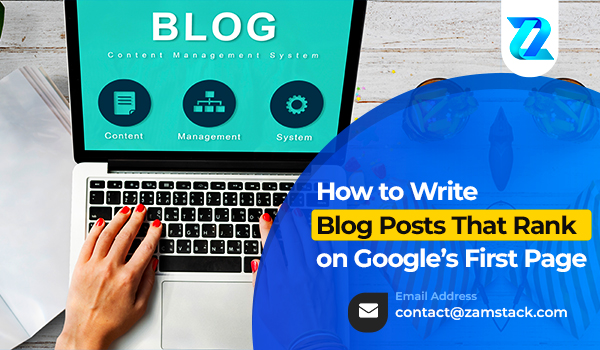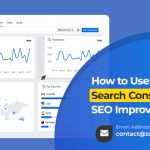Want to get your blog post on the first page of Google? It takes more than just writing—it requires strategy, SEO know-how, and user-focused content. In this guide, we’ll walk you through the exact steps to create blog posts that not only rank but also drive traffic and engage readers. Whether you’re a beginner or looking to sharpen your SEO writing skills, this post has everything you need to succeed.
Why Blogging Still Matters in 2025
Let’s face it—blogs aren’t going anywhere. In fact, with search engines getting smarter and more user-focused, blog content is one of the most powerful ways to show up on the first page of Google. Whether you’re a business owner, marketer, or solopreneur, if you’re not blogging strategically, you’re missing out on major SEO gold.
What It Really Takes to Rank Today
Google’s algorithm has evolved. It’s no longer about keyword stuffing or just publishing lots of content. Now, it’s all about relevance, authority, and user satisfaction. To reach the top spot, your blog post needs to check all the SEO boxes and deliver real value to the reader.
Understanding Google’s First Page Ranking Factors
The Role of Relevance and Search Intent
Google loves content that satisfies the why behind a user’s search. Are they looking to learn, compare, buy, or fix something? If your blog directly answers their intent with clarity and depth, you’re already halfway up the ladder.
E-E-A-T and Google’s Helpful Content Update
Experience, Expertise, Authoritativeness, and Trustworthiness—this is Google’s holy grail. Add your personal experience, credentials, data, and honest advice to your content. Google’s 2024 Helpful Content Update prioritizes content that’s genuinely useful and not just optimized for bots.
AI-Generated Content vs Human Touch
Yes, AI tools can speed up writing. But purely AI-written posts without human editing rarely rank. Add personal insights, unique analogies, and real examples to stand out.
Planning Your Blog Post for SEO Success
Conducting Keyword Research Like a Pro
Start with keyword tools like Ahrefs, SEMrush, or Ubersuggest. Focus on long-tail keywords like “how to write ranking blog posts” or “SEO-friendly blog post format”—these are less competitive and often more intent-driven.
Using Long-Tail Keywords Strategically
Long-tail keywords often have lower competition and higher conversion. Sprinkle them naturally throughout your post, especially in headings and near the beginning of paragraphs.
Identifying User Intent
Break down your keyword into the 4 types of search intent: informational, navigational, transactional, and commercial. Align your content format accordingly.
Finding Trending Topics with SEO Tools
Use tools like Exploding Topics or Google Trends to discover what people are buzzing about. Trending keywords like “voice search optimized blog writing” can give you an edge.
Structuring a Blog Post for SEO
Best Blog Post Length for Ranking
According to multiple studies, blog posts that rank on page one often have 1,800 to 2,500 words. Why? They cover the topic comprehensively and answer multiple questions in one place.
How to Structure Blog Posts for SEO
Think of your blog post like a well-organized book. Clear headings, logical flow, bullet points, and scannable content improve dwell time and user experience.
H1, H2, H3 Usage for Better Crawlability
Use only one H1 (the title), then use H2s for main sections, H3s for subpoints, and H4s when needed. It’s like a table of contents for both users and Google bots.
SEO-Friendly Blog Post Format
-
Introduction (hook the reader)
-
Body (clear sections answering key questions)
-
Conclusion (summarize and encourage action)
-
FAQ (address extra queries)
Blog URL Structure Best Practices
Keep URLs short, descriptive, and keyword-rich. For example:www.example.com/blog/write-ranking-blog-posts
Writing the Content That Ranks
How to Write Blog Introductions That Rank
The intro must hook the reader, explain what they’ll get, and match their search intent—all within 100 words. Use questions, facts, or storytelling.
Blog Post Hook Formulas That Grab Attention
-
Ask a bold question: “Want your blog on Google’s front page?”
-
Drop a stat: “Only 0.63% of people click on results past the first page.”
-
Create curiosity: “You might be making this simple SEO mistake…”
Storytelling Techniques for Blogs
Tell a personal story, client success, or case study. People remember stories more than facts.
Power Words for Higher Click-Through Rates
Words like “proven,” “secret,” “ultimate,” “easy,” “guaranteed” improve CTR when used in titles and meta descriptions.
How to Write Compelling Blog Conclusions
End by summarizing the key takeaways, reaffirming the value, and adding a clear CTA—like commenting, subscribing, or contacting your team.
Blog Post SEO Optimization Tips
Keyword Optimization for Blog Posts
-
Primary keyword in H1, first 100 words, and meta title
-
Secondary keywords in H2s and throughout the text
-
Avoid keyword stuffing—aim for natural placement
Image Optimization for Blog SEO
-
Compress images for faster loading
-
Use descriptive file names and alt text (with keywords)
Blog Post Meta Description Best Practices
Keep it under 155 characters. Use action words, your main keyword, and a value statement.
How to Use Headings in Blog Posts for SEO
Headings not only break up content but also help Google understand your structure. Each section should address a specific search intent.
Canonical Tags and Schema Markup
Use canonical tags to prevent duplicate content issues. Add schema markup (especially “Article” or “BlogPosting”) to boost your appearance in rich snippets.
Enhancing User Experience for Better Rankings
Mobile-Friendly Blog Design
With mobile-first indexing, your blog must be 100% responsive. Use readable fonts, tappable buttons, and adaptive images.
Blog Loading Speed Optimization
Compress images, enable lazy loading, use a CDN, and minimize JavaScript to keep your blog snappy.
Internal Linking Strategy for Blogs
Link to older posts to reduce bounce rate and guide readers deeper into your site. Use descriptive anchor text, not just “click here.”
Updating and Republishing Old Blog Posts
How to Update Old Blog Posts to Rank Higher
Update outdated stats, broken links, improve keyword usage, and add new sections. Google loves fresh content.
Refreshing Content and Meta Data
Revise the title and meta description if CTR is low. Update schema, images, and structure for improved performance.
Tools to Optimize Your Blog Posts
Using SurferSEO, Clearscope, Frase.io, and ChatGPT
These tools help analyze top-ranking content, suggest keyword usage, and improve readability. Combine them with personal writing for best results.
Blog Post Optimization Audit Tools
Tools like Screaming Frog, SEMrush, and Yoast help audit technical SEO and on-page elements. Run audits regularly to stay ahead.
Publishing and Promotion Strategy
Optimal Publishing Frequency for SEO
Consistency is key. Aim for 2–4 posts per month if possible, with quality always being the priority.
Leveraging Social Media and Backlinks
Promote your post across channels and ask partners for backlinks. Outreach and guest posting still work wonders.
How Zamstack Technologies Can Help You Rank
Our SEO Blog Writing Services
At Zamstack Technologies, we specialize in crafting SEO-optimized blog content that ranks. From keyword research to publishing, we’ve got your back.
Why Choose Zamstack Technologies
-
100% human-written content
-
In-depth keyword and competitor analysis
-
E-E-A-T focused blog strategies
-
Technical and on-page optimization
-
Proven ranking success across niches
Let Zamstack Technologies take your blog from buried to booming.
Conclusion
Writing blog posts that rank on Google’s first page isn’t rocket science—but it does require strategy, effort, and consistency. By applying SEO best practices, delivering value-driven content, and optimizing every inch of your post, you can climb the rankings and attract quality traffic. Don’t settle for page two. Start implementing these tips today, or let Zamstack Technologies do it for you!
FAQs
1. What’s the ideal blog post length for Google ranking?
Around 1,800–2,500 words tends to perform best for in-depth topics and informational keywords.
2. How do I optimize images in blog posts?
Compress images, use descriptive alt text, and name files with relevant keywords.
3. Can I rank using AI-generated blog content?
You can—but only if you humanize it. Add personal experience, storytelling, and unique insights.
4. What’s the best internal linking strategy?
Link to related blog posts using descriptive anchor text. Keep the user journey in mind.
5. How often should I update blog content?
Every 3–6 months. Keep stats, keywords, and references current to maintain rankings.













